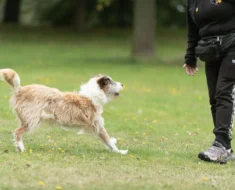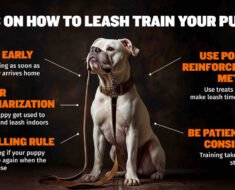You want your puppy to grow up happy, confident, and well-behaved. But how do you make sure your little furry friend gets the right social experiences without risking their health?
Socializing puppies after their first vaccinations is a crucial step, and having a safe plan can make all the difference. You’ll discover simple, effective ways to introduce your puppy to new sights, sounds, and friends — without worry. Keep reading to learn how to build a strong foundation for your puppy’s future, one safe step at a time.
Timing Puppy Socialization
Puppies usually get their first vaccinations around 6 to 8 weeks old. Ideal socializationstarts after the full set of shots, often by 12 to 16 weeks. This period is criticalfor learning to meet new people and other pets safely.
Early socialization helps puppies become friendly and confident. But risks exist if done too soon, like catching diseases. A safe planincludes controlled environments and healthy playmates.
Balance is key. Meeting others too early may cause illness. Waiting too long can lead to fear or aggression. Gradual, supervised social time after vaccinations builds trustand social skills.
Creating A Safe Environment
Controlled settingshelp keep puppies safe during socializing. Choose places where you can watch your puppy closely. Parks with few dogs or friend’s yards work well. Avoid crowded spots to reduce stress and risk of illness. A calm place helps puppies feel happy and safe.
Keep everything clean. Wash your hands before and after meeting puppies. Use sanitizerson toys and surfaces. Make sure other dogs are healthy and vaccinated. Watch for signs of sickness in your puppy or others.
| Health Precautions | Details |
|---|---|
| Vaccinations | Puppies must finish first shots before socializing |
| Cleanliness | Sanitize toys and wash hands often |
| Safe Distance | Keep puppies away from sick dogs |
| Calm Spaces | Choose quiet, controlled areas for meetings |
Introducing New Experiences
Start by letting your puppy meet calm and healthy people. Keep visits short and gentle. Let your puppy sniff and see new faces at their own pace. Use soft voices and slow movements. This helps build trust and comfort.
Introduce other pets slowly. Begin with pets that are vaccinated and friendly. Watch their body language to ensure no stress or fear. Let them interact on neutral ground, like a park or yard. Always supervise closely to keep all safe.
Expose your puppy to different surfaces and sounds. Walk on grass, pavement, and carpet to build confidence. Play sounds like doorbells, cars, or birds softly at first. Gradually increase volume to avoid fear. This helps puppies adjust to new environments easily.

Credit: www.petmd.com
Reading Puppy Body Language
Comfort signsshow a happy, relaxed puppy. They wag their tail gently, have soft eyes, and a loose body. Puppies may play bow or lick their lips calmly. These signs mean they feel safe and ready to meet others.
Stress signsinclude tucked tails, yawning, or licking lips fast. Puppies may freeze, growl quietly, or try to hide. These signs show they feel uneasy or scared.
Adjusting socialization pacemeans watching these signs closely. Move slowly if the puppy looks stressed. Let them take breaks and try again later. Keep meetings short and positive. Always follow the puppy’s comfort level to build trust and joy.
Using Positive Reinforcement
Rewarding calm behavior helps puppies learn good manners. Give treats or gentle praise when they stay relaxed around new people or animals. This shows them that staying calm is a good choice.
Building confidence happens in small steps. Let puppies meet new friends slowly and safely. Start with short visits in quiet places. Gradually increase the time and the number of new things they see.
Use a soft voice and gentle petting to comfort shy puppies. Let them explore at their own pace. Never force a puppy to meet others if it seems scared.
| Step | Action | Goal |
|---|---|---|
| 1 | Give treats for calm behavior | Encourage good manners |
| 2 | Start with short, quiet meetings | Build comfort slowly |
| 3 | Use gentle voice and touch | Reduce fear and stress |
| 4 | Increase exposure step-by-step | Boost confidence safely |

Credit: www.pumpkin.care
Common Challenges And Solutions
Fear and anxietyin puppies often show as trembling, hiding, or barking. Stay calm and use a soft voice to help them feel safe. Offer treats and gentle pets to build trust slowly. Avoid forcing the puppy into scary situations. Let them explore at their own pace. Small steps work best.
Overstimulationhappens when puppies get too excited or tired. Signs include jumping, biting, or whining. Stop playtime for a short rest to calm them down. Provide a quiet space where they can relax. Watch their body language to know when they need a break. This helps prevent stress and keeps socializing fun.
Consulting Professionals
Professional guidanceensures safe puppy socialization. Trainers help identify behavior issues early. They teach owners how to build confidencein puppies. Trainers create step-by-step planssuited to each puppy’s needs.
Veterinariansgive advice on vaccination timingand health checks. They confirm when it’s safe to meet other dogs. Vets can spot health risksthat might affect socializing. Their advice keeps puppies healthy and happy.
| When to Seek Trainer Help | Role of Veterinarians |
|---|---|
| Puppy shows fear or aggression | Advise on vaccine schedule |
| Owner unsure how to start socializing | Check puppy health before outings |
| Need help with obedience basics | Recommend safe play environments |

Credit: www.chewy.com
Frequently Asked Questions
When Can I Start Socializing My Puppy After Vaccinations?
You can start socializing your puppy shortly after their first vaccinations. Ensure their immune system is strong enough. Begin with controlled environments and safe interactions to minimize disease risks.
How Do I Create A Safe Socialization Plan For Puppies?
A safe plan includes gradual exposure to new people, dogs, and environments. Use clean, vaccinated playmates and avoid high-risk areas. Monitor puppy’s reactions and adjust the pace accordingly.
What Are The Best Places To Socialize Puppies Post-vaccination?
Choose places with limited contamination risks, like friend’s homes or clean outdoor areas. Avoid dog parks or crowded public spots until full vaccination is complete.
How Important Is Puppy Socialization After First Vaccines?
Early socialization builds confidence and reduces behavioral problems. It helps puppies adapt to various stimuli safely, promoting healthy development and better adult behavior.
Conclusion
Socializing puppies after vaccinations builds their confidence and happiness. Start slow and keep experiences positive and safe. Watch your puppy’s reactions and adjust the plan as needed. Meeting new friends helps puppies grow into well-behaved dogs. Patience and care make socializing easier for both of you.
Enjoy each moment of this important journey together. Your puppy will thank you with love and good behavior.





